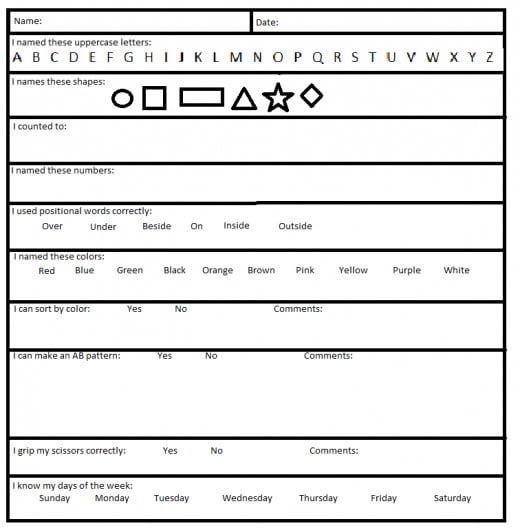Child Mental Health Assessment Tools

There are several different types of assessment tools for your child's health. They assess social-emotional, mental health, coping, functional impairment, and other areas of your child's health. Many of these assessments are done by a questionnaire or screening. These assessments can be used to help identify developmental delays, depression or anxiety in your child, however, further testing would be needed to actually diagnose any problems uncovered by these tests.
I know every time I go to the doctors office for any of the kids' doctors appointments, they hand me the questionnaire for their age group and I sit and do it while we wait for the doctor. I also get some copies of questionnaires when it comes to elementary school. Starting kindergarten and all throughout the year the teachers are doing assessments on my kids to make sure they are learning properly.
Here are just a few of different child mental health assessment tests and what each one covers, along with advantages and disadvantages of each one.
Instrument
| Age Range
| Time to Complete
| Reporter
| Area Assessed
|
|---|---|---|---|---|
Behavior and Emotional Rating Scale (BERS-2)
| 5-18 years
| 10-15 minutes
| Parent, Teacher, Youth
| Social Emotional
|
Child and Adolecent Functional Assessment Scale (CAFAS)
| 4-18 years
| 30 minutes
| Trained Rater
| Functional Impairment
|
Child and Adolecent Needs and Strengths (CANS)
| 0-17 years
| 10 minutes
| Case Worker
| Mental Health
|
Clinical Assessment of Behavior (CAB)
| 2-18 years
| 10-15 minutes
| Parent, Teacher
| Multidemensional
|
Coping Inventory and Early Coping Inventory
| 4 months - Adult
| up to 1+ hour
| Observer
| Coping
|
Early Screening Project
| 3-5 years
| 1-2 hours
| Teacher
| Social Emotional
|
BERS-2
The Behavior and Emotional Rating Scale assessment was designed to measure the personal strengths and competencies of children ages 5-18 years old. This assessment measures interpersonal strength, involvement with family, school functioning, affective strength and career strength.
Some of the advantages of this assessment are:
- The wide age range.
- An option for multiple reporters.
- Measures strengths in addition to problems or concerns.
Some of the disadvantages of this assessment are:
- Primarily designed for identification of strengths rather then mental health concerns or problems.
- Interpretation requires clinical training and experience.
CAFAS
The Child and Adolescent Functional Assessment Scale assesses children and adolescents' degree of impairment in day-to-day functioning due to emotional, behavioral, psychological, psychiatric, or substance use problems. It does not actually measure mental health or emotional/behavioral/psychological problems but focuses on functional impairment in five different areas. These areas include role performance, behavior toward others, moods and self harm, substance abuse, and thinking.
Some advantages of this assessment are:
- Wide age range
- Widely used in child service fields.
- Measures strengths in addition to problems or concerns.
Some disadvantages of this assessment are:
- Does not include youth self-report for adolescents.
- Measures functional impairment rather then the actual mental health or social emotional concerns/strengths underlying the impairment.
CANS
The Child and Adolescent Needs and Strengths Assessment is an assessment of the child's' need and strengths. There are two versions of this assessment, one for ages 0-5 years old and the other is for children 5-17 years old. It was developed with the intent of creating a common assessment tool across systems such as mental health and addictions, child welfare, juvenile justice, Medicaid and education. This assessment has several clusters: Problem Presentation, Risk Behaviors, Functioning, Care Intensity and Organization, Family/Caregiver Needs and Strengths, and Strengths.
Some of the advantages of this assessment are:
- Appropriate for children and adolescents of all ages.
- Measures strengths in addition to problems or concerns.
- Widely used in child service fields.
Some of the disadvantages of this assessment are:
- Does not include a questionnaire or interview to obtain the information needed for the CANS.
CAB
The Clinical Assessment of Behavior assesses adjustment, psychosocial strengths ans weaknesses and problem behaviors in children and adolescents ages 2-18 years. This assessment assists in the identification of children and adolescents who are in need of behavioral, educational, or psychiatric treatment or intervention.
Some advantages of this assessment are:
- Wide age range.
- Option for multiple reporters.
- Measures strengths in addition to problems or concerns.
Some disadvantages of this assessment are:
- Does not include youth self-report for adolescents.
- Graduate level clinical training is needed for interpretation.
Coping Inventory and Early Coping Inventory
The Early Coping Inventory is a measure of early childhood coping behavior for children with a chronological or developmental age between 4 and 36 months. It is used for intervention planning. This assessment has three coping clusters: sensorimotor organization, reactive behavior and self-initiated behavior.
The Coping Inventory is used to assess the behavior patterns and skills used by children ages 3-16 years old to meet personal needs and adapt to the demands of their environment. This assessment also uses three coping styles: Productive and Nonproductive, Active and Passive, and Flexible and Rigid.
Some advantages of this assessment are:
- Appropriate for use with infants from 4 months old and up.
- Measures strengths in addition to problems or concerns.
Some disadvantages of this assessment are:
- Measures coping rather then mental health or social-emotional concerns and strengths.
- Does not include youth self-report for adolescents.
- Lengthy.
Early Screening Project
The Early Screening Project is a screening process for social, emotional or behavioral delays or disorders in children ages 3-5 years old. It is used to identify adjustment problems, and screens for children who may be at risk for emotional problems, speech and language difficulties, impaired cognitive ability, attention deficits, and hyperactivity.
Some advantages of this assessment are:
- Option for multiple reporters.
Some disadvantages of this assessment are:
- Narrow age range.
- Primarily designed for the school environment.









